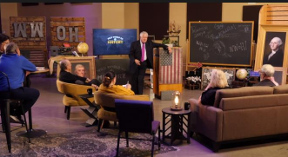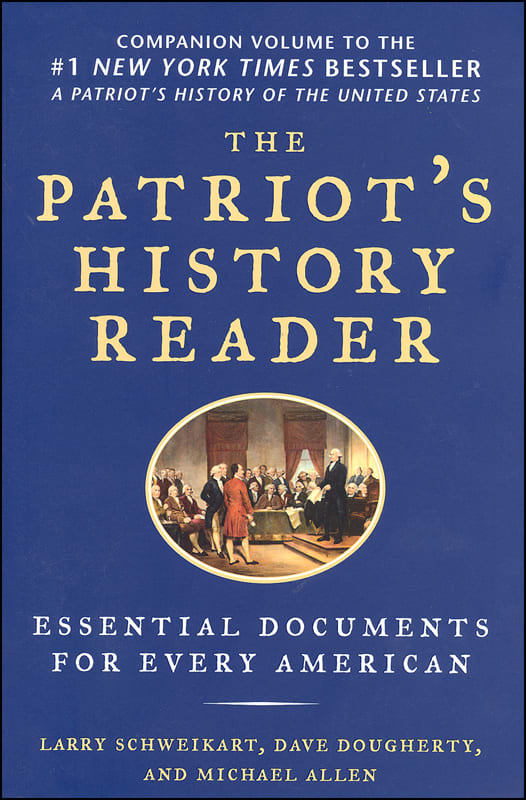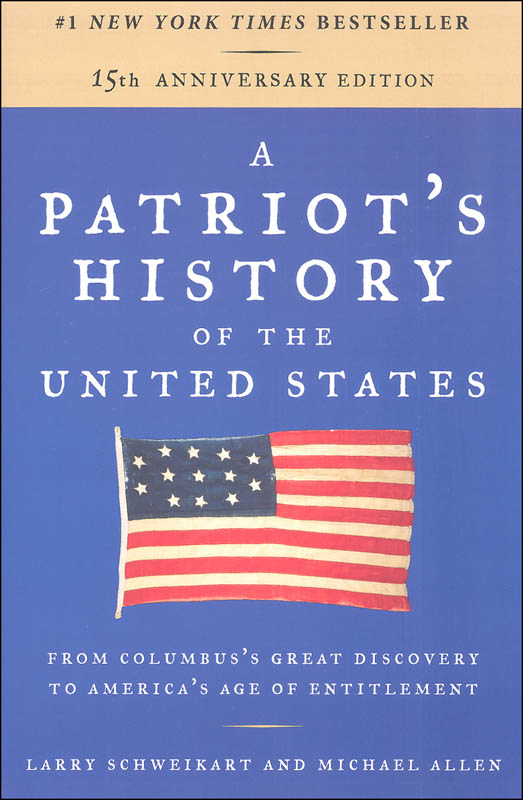Larry Schweikart, co-author of A Patriot’s History of the United States and A Patriot’s History of the Modern World: Volume I and Volume II, is the author and presenter for the Wild World of History online courses for American history and world history. These video-based courses for teens and adults require the use of books Schweikart has co-authored, and each course should take one school year to complete. Schweikart also has created some shorter, special-topic courses that I will discuss later in this review.
The series title, Wild World of History, reflects Schweikart’s penchant for storytelling that brings history to life. He loves to tell stories of little known but influential events, such as how spies for the abolitionist movement transitioned into another type of spy by doing background checks on people, eventually becoming Dunn and Bradstreet®—one of our modern-day sources for business credit scores. Schweikart also enjoys relating ironic stories such as the origin of the Democratic Party as a pro-slavery party just prior to the Civil War.
Schweikart wants to give his audience enough information to grasp underlying motivations, the impact of ideas, political plotting, and unintended consequences that have shaped history. Because of this, there are both more content and more stories in his courses than in most courses for either high school or college. Even so, Schweikart's lively speaking and writing styles make it easier than you would think to cover so much material. While students in about tenth grade and above should be able to complete these courses, adults are likely to find them interesting as well. I would compare them favorably to courses offered by The Great Courses Plus. (I have reviewed some of their courses, such as The Foundations of Western Civilization and America's Founding Fathers.)
Schweikart has created two complete video courses: American History and World History Since 1775. Purchase of either course includes one year of access to resources available through Wild World of History's VIP Membership. (VIP Membership is also available apart from these courses.) These resources include a number of "Wild World Wednesday Webcasts," special topic presentations by Schweikart. These are great supplements to history. Many of them address controversial topics that students need to understand, such as the presentations "Socialism and Capitalism... The Untold Truth," "The Lincoln Nobody Knows," and "The Transformation of the American Economy."
How the Courses Work
Both courses include access to video lectures plus PDFs for a teaching guide, a student guide, and seven tests with answer keys. Students will also need the course books which have to be purchased separately. (New and used copies are readily available through Amazon.com.) A Word document titled "Teaching US and World History through the Wild World of History Courses" provides some critical details about the courses, especially for World History Since 1775. In that document, Schweikart explains how you might schedule the courses, and he provides schedules for the reading from the course books for the world history course. (The Word document can be read without having Microsoft Word® installed on your computer.)
For American History, Schweikart presents the lectures before a small audience while he stands on a stage set decorated with lots of interesting props. The audience is missing for the world history course, but Scheikart is an excellent presenter in both settings.
Lectures vary in length from under a half hour to just over an hour. Students can watch these in one sitting, but the longer lectures might be watched more profitably in two or three sittings. Each video covers two or three topics, and the breaks between topics make natural breakpoints where students might pause watching if they prefer shorter sessions.
In the lectures it is clear Schweikart knows his subject so well that he often speaks without reference to his notes. He tells stories and makes connections that bring the subject matter to life. He uses humor and even sings a line from a song once in a while to illustrate a point.
The student guide for the American History course has an average of about 12 pages per lesson, while the student guide for World History Since 1775 has ten or fewer pages per lesson. Aside from an introductory page for each lesson, the rest of the pages present essay questions with lined space for students to write their responses. The questions challenge students to think deeply. A good example is a multi-part question at the end of the first lesson in American History that asks, “What was the Glorious Revolution? Why was it so 'glorious'? What impact did this English revolution have in America?” Questions labeled “Learning at a Higher Level” are interspersed among other questions and should be considered optional.
The teacher guides present course objectives, suggest supplementary videos (clips, documentaries, and movies), list the student questions, provide suggested answers, and conclude each lesson with suggested activities. The activities appeal to different learning styles and might include crafts or building projects, research, writing, cooking, art, role playing, or field trips. While parents do not need to watch all of the videos and read all of the material, it is so interesting that parents are likely to enjoy learning along with students.
American History
In American History, Schweikart makes it clear that he is promoting a particular view of history—a Christian and patriotic view that advocates the idea of American exceptionalism. As he explains, the concept of American exceptionalism is based on historical observations that the United States developed a ”unique and distinct character far different from the European nations the inhabitants had left” (p. 41, A Patriot’s History of the United States).
The required course books are A Patriot’s History of the United States (APHUS) and A Patriot’s History Reader. Reading assignments in APHUS are not specified in the student book or teacher guide, but they are mentioned at the beginning of each of the videos. In addition to the two books and the PDFs, students will also use free, downloadable resources for this course that include a file of maps and slides.
The teacher and student guides work together to present the 22 chapters of APHUS. The lesson for each chapter will take a number of days to complete. There is one lecture for all except the fifth lesson, which has three. In addition to watching the lectures, students read a chapter in APHUS and answer questions in the student guide. Two additional chapters have been added since I wrote my review, covering the years 2018 up through 2025. Lectures and questions are still under development for the new chapters. (Note that the two new chapters are very detailed, getting into minutiae like an extended discussion of the Trump-Biden debate of June 2024.)
Parents or teachers need to be alert to a few questions or notes in the student guide where they might have to decide how much work to require of the student. For example, one question reads:
Students might be asked to discuss why, say, Africans or Middle Easterners were not exploring these areas [in the New World]. A good out-of-book exercise would be to find out what happened to China’s "golden fleet," which ended their exploration (Lesson 1, p. 2).
The out-of-book exercise will send students off to do extra research about the golden fleet before they can participate in a discussion, so this is intended to be an optional assignment. (And, also it's a little odd to have comments like this addressed to parents in the student guide. These are rare, but it's worth scanning through ahead of time to spot them.)
“Learning at a Higher Level” questions in this course often require students to read primary source documents included in The Patriot’s History Reader. For example, a question on page nine of the first lesson reads: “Using the Mayflower Compact, discuss the Pilgrims’ attempts to reassure the King that they were not being rebellious.”
Each of the course's seven tests has multiple-choice questions, a “documents-based” question (using either a document from The Patriot’s History Reader or a document included within the test), and an optional essay question. An answer key follows each test.
This American History course reflects Schweikart’s opinions. He doesn't claim to be neutral and doesn't believe it's possible to present history neutrally. For instance, Schweikart’s repeated rejection of the southern states’ justifications for the Civil War based on states’ rights makes it clear that he views the states' rights arguments only as veiled defenses for slavery. It is fair to say that this course avoids neutrality more than most history courses and is all the more interesting for that approach. However, it is important for students to be aware of this.
World History Since 1775
World History Since 1775 is a modern history course for high school students that focuses heavily on the United States. The course components are 15 streamed video lectures, online tests, PDF files for both the student and teacher for each lesson, and the two-volume textbook, A Patriot’s History of the Modern World. The introduction to the first volume of the textbook for this course says:
A Patriot’s History of the Modern World follows the history of the last century to the end of World War II along three thematic lines: the struggle between Progressivism and Constitutionalism within America; the rise of American global power and its corollary in the decline of European constitutionalism and international influence; and the rise of new, non-western powers challenging the United States for world leadership (or, perhaps, dominance).
In addition to the course components that I listed above, students will also need access to primary sources available on the internet, such as The Declaration of the Rights of Man and of the Citizen. These documents are listed and described in the Word document I mentioned earlier, "Teaching US and World History through the Wild World of History Courses."
The course videos and textbooks present a conservative, patriotic viewpoint. Occasionally, the course also reflects a Christian (sometimes Protestant) interpretation of events
The fifteen lessons are divided into two parts (corresponding to the two volumes of the textbook) titled Part 1: Origins of the Modern World Through the Era of Global European Dominance and Part 2: Emergence of the Modern World Order. While there are fifteen video lectures, one for each lesson, the lessons vary in the amount of time they require. Most lessons should take about one to two weeks to complete, although some lessons toward the end of the course will take longer because students are assigned three or four chapters of the textbook to read along with each video lecture.
Even though the title makes it sound like the course starts with the year 1775, Shweikart summarizes key ideas, events, and people who helped to shape history before that time. For example, he begins with a background overview, examining key ideas from 800 to 1800 A.D. that helped to shape history—ideas such as monarchies, common law, private property, the free market, and the scientific revolution.
Other Courses
Schweikart also presents shorter, special-topic courses with material to be read online. These courses do not have tests or ancillary material.
1620 Default
The 1620 Default course was created in response to the 1619 Project. While the 1619 Project takes a highly negative view of the United States, this course reviews American history through the positive lens of American Exceptionalism. Even so, it condemns slavery and acknowledges other moral lapses of America. The course is presented in 12 chapters.
The Horrible History of Howard Zinn... And what to do about it!
Howard Zinn has had a tremendous impact on how American history has been taught ever since the publication of his 1990 book, A People's History of the United States. Writing from a Marxist point of view, Zinn takes a pessimistic view of the U.S., highlighting and dwelling upon the negative. Schweikart says that it's even worse because Zinn's presentation is often dishonest. In this five-part course, Schweikart explains one of the techniques used by Zinn of quoting information from different sentences and leaving out other information, effectively misrepresenting what someone said. In the second lesson, Schweikart uses an example of Zinn's treatment of quotations from Christopher Columbus:
Zinn did this with regards to his discussions about Columbus noting that the Arawak Indians would “make fine servants,” and joining it to earlier discussions without informing the reader that Columbus was noting that the Arawaks had been in an ongoing conflict with other Indians who wanted to enslave them, and he was impressed that the Arawaks were strong, healthy looking people who to other Indians would “make fine servants.” (See Zinn, People’s History, p.1) But the point is, Zinn was hardly the first to do this, and had learned at the hands of these master historical manipulators.
Schweikart addresses other misrepresentations such as Zinn's historically inaccurate portrayal of the Aztec civilization and consistent presentation of early American colonists as being antagonistic toward native Americans (and vice versa).
This short course provides a counterpoint to the revisionist version of U.S. history that has been taught to millions.
Enduring Lessons on Life and Citizenship
Enduring Lessons on Life and Citizenship will be an 11-lesson course on government and citizenship. This course, under development as I write this review, covers many current issues such as why we have the electoral college and why there are only two effective political parties.











